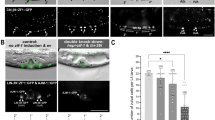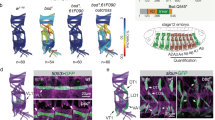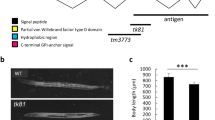Abstract
DURING the induction of the Caenorhabditis elegans vulva, cell signalling causes initially equipotent cells to express a reproducible pattern of cell fates1,2. The position of the anchor cell determines the pattern of vulval precursor cell fates, such that the closest precursor cell (P6.p) expresses the primary cell fate, the next closest cells (P5.p and P7.p) both express the secondary cell fate, and each of the precursor cells located at a distance (P3.p, P4.p and P8.p) express the tertiary cell fate (Fig. la)3–5. We present data indicating that this stereotypical pattern of cell fates can be generated by sequential signals. We identified genetic mosaic animals in which P5.p and P7.p were defective in the anchor-cell signal-transduction pathway and observed that these cells adopted the secondary cell fate, indicating that anchor-cell signal transduction is not required for the expression of the secondary cell fate. These results suggest that the anchor cell induces P6.p to express the primary cell fate, and that P6.p subsequently induces P5.p and P7.p to express the secondary cell fate.
This is a preview of subscription content, access via your institution
Access options
Subscribe to this journal
Receive 51 print issues and online access
$199.00 per year
only $3.90 per issue
Buy this article
- Purchase on Springer Link
- Instant access to full article PDF
Prices may be subject to local taxes which are calculated during checkout
Similar content being viewed by others
References
Horvitz, H. R. & Sternberg, P. W. Nature 351, 535–541 (1991).
Eisenmann, D. M. & Kim, S. K. Curr. Opin. Genet. Dev. 4, 508–516 (1994).
Kimble, J. Devl Biol. 87, 286–300 (1981).
Sternberg, P. W. & Horvitz, H. R. Cell 44, 761–772 (1986).
Thomas, J. H., Stern, M. J. & Horvitz, H. R. Cell 62, 1041–1052 (1990).
Hill, R. J. & Sternberg, P. W. Nature 358, 470–476 (1992).
Aroian, R. V., Koga, M., Mendel, J. E., Ohshima, Y. & Sternberg, P. W. Nature 348, 693–699 (1990).
Ferguson, E. L. & Horvitz, H. R. Genetics 110, 17–72 (1985).
Sulston, J. E. & Horvitz, H. R. Devl Biol. 82, 41–55 (1981).
Ferguson, E. L., Sternberg, P. W. & Horvitz, H. R. Nature 326, 259–267 (1987).
Herman, R. K. Genetics 108, 165–180 (1984).
Herman, R. K. J. Neurogenet. 5, 1–24 (1989).
Lackner, M. R., Kornfeld, K., Miller, L. M., Horvitz, H. R. & Kim, S. K. Genes Dev. 8, 160–173 (1994).
Aroian, R. V. & Sternberg, P. W. Genetics 128, 251–267 (1991).
Sternberg, P. W. Nature 335, 551–554 (1988).
Greenwald, I. & Rubin, G. M. Cell 68, 271–281 (1992).
Slack, J. M. W. Curr. Biol. 4, 116–126 (1994).
Johnson, R. L., Riddle, R. D. & Tabin, C. J. Curr. Opin. Genet. Dev. 4, 535–542 (1994).
Basler, K. & Struhl, G. Nature 368, 208–214 (1994).
Ingham, P. W. Curr. Biol. 4, 347–350 (1994).
Ferguson, E. L. & Anderson, K. V. Cell 71, 451–461 (1992).
Sulston, J. E. & Horvitz, H. R. Devl Biol. 56, 110–156 (1977).
Sternberg, P. W. & Horvitz, H. R. Cell 58, 679–693 (1989).
Miller, D. M., Niemeyer, C. J. & Chitkara, P. Genetics 135, 741–753 (1993).
Sulston, J. E., Schierenberg, E., White, J. G. & Thomson, J. N. Devl Biol. 100, 64–119 (1983).
Fire, A. EMBO J. 5, 2673–2680 (1986).
Mello, C. C., Kramer, J. M., Stinchcomb, D. & Ambros, V. EMBO J. 10, 3959–3970 (1991).
Yuan, J. Y. & Horvitz, H. R. Devl Biol. 138, 33–41 (1990).
Austin, J. & Kimble, J. Cell 51, 589–599 (1987).
Aroian, R. V., Lesa, G. M. & Sternberg, P. W. EMBO J. 13, 360–366 (1994).
Author information
Authors and Affiliations
Rights and permissions
About this article
Cite this article
Simske, J., Kirn, S. Sequential signalling during Caenorhabditis elegans vulval induction. Nature 375, 142–146 (1995). https://doi.org/10.1038/375142a0
Issue Date:
DOI: https://doi.org/10.1038/375142a0
This article is cited by
-
Interpretation of morphogen gradients by a synthetic bistable circuit
Nature Communications (2020)
-
Robustness and evolution: concepts, insights and challenges from a developmental model system
Heredity (2008)
-
Visualization of C. elegans transgenic arrays by GFP
BMC Genetics (2006)
-
Evolution of development in closely related species of flies and worms
Nature Reviews Genetics (2002)
-
Facilitation of lin-12-mediated signalling by sel-12, a Caenorhabditis elegans S182 Alzheimer's disease gene
Nature (1995)
Comments
By submitting a comment you agree to abide by our Terms and Community Guidelines. If you find something abusive or that does not comply with our terms or guidelines please flag it as inappropriate.



